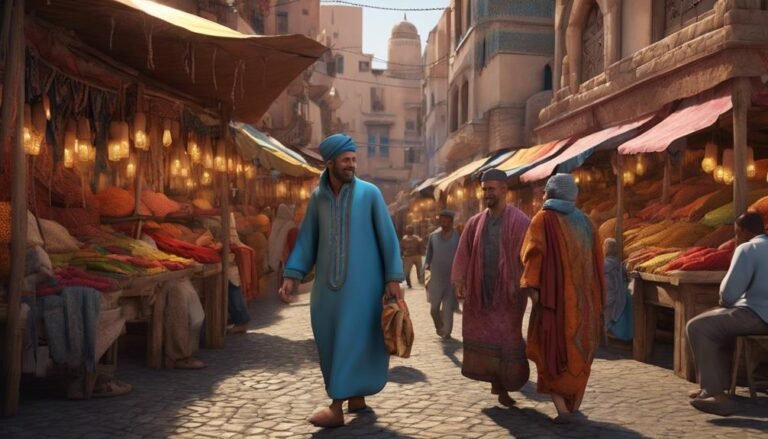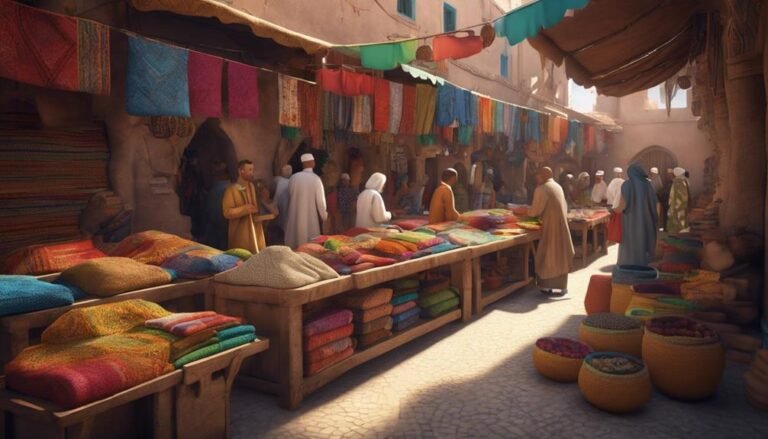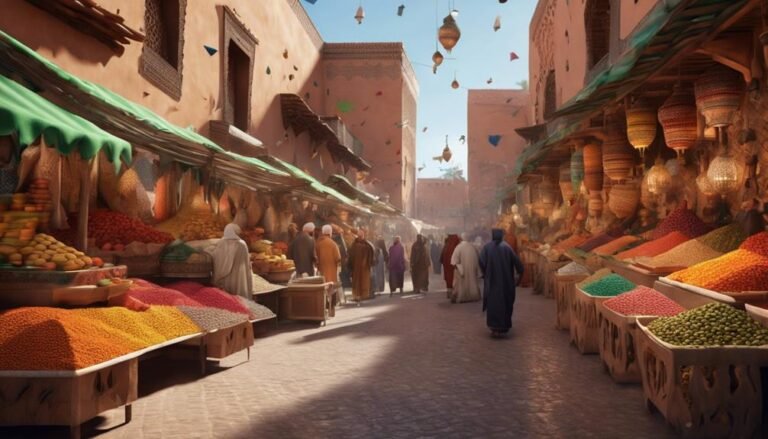In Morocco, the climate varies due to geographical diversity. Expect Mediterranean influences along the coast, arid conditions in the desert, temperature fluctuations in the High Atlas Mountains, and ocean effects along the Atlantic. Summers bring soaring temperatures, especially inland, while winters bring chilliness, particularly in the mountains. Rainfall differs annually, impacting regions uniquely. Be ready for dry summers and wet winters, especially in the north. Extreme heatwaves affect agriculture and tourism, prompting the need for adaptation strategies. For more insights on Morocco's climate zones and challenges, explore further into the data provided.
Key Takeaways
- Morocco has diverse climates, from Mediterranean to desertic regions.
- Coastal areas have moderate temperatures, attracting tourism and economic activities.
- Seasonal temperature variations impact agriculture and tourism.
- Hot summers and cold winters characterize Morocco's continental climate.
- Rainfall varies annually, with winter months being the wettest.
Geographical Diversity
Located in North Africa, Morocco exhibits a diverse range of geographical features that greatly influence its climate patterns. The country is characterized by a variety of climate zones, ranging from Mediterranean along the coast to arid and semi-arid in the interior regions. This diversity in climate zones is closely linked to the country's biodiversity, with each zone supporting a unique array of flora and fauna.
Elevation effects play an important role in shaping the climate in Morocco. As elevation increases, temperature gradients become more pronounced, leading to cooler temperatures in mountainous regions compared to low-lying areas. The High Atlas mountain range, for example, experiences different climatic conditions than the Sahara Desert due to its higher elevation.
Mediterranean Influences
Incorporating influences from the Mediterranean region, Morocco's climate showcases distinct characteristics shaped by proximity to this sea. The Mediterranean influences play a significant role in shaping Morocco's agriculture practices and crop yields. The temperate climate, moderated by the sea, allows for a variety of crops to thrive, including olives, citrus fruits, and vineyards. The mild winters and hot summers create favorable conditions for agriculture throughout the year, contributing to the country's agricultural productivity.
Moreover, the Mediterranean influences also impact tourism in Morocco, influencing seasonal trends and visitor preferences. The coastal regions experience a more moderate climate compared to inland areas, attracting tourists seeking a milder climate for leisure activities. The summer months see an influx of tourists to coastal cities like Casablanca and Tangier, drawn by the pleasant weather and beach attractions. Conversely, the cooler winters in these regions cater to visitors looking to explore cultural sites and enjoy outdoor activities without the scorching heat. Overall, the Mediterranean influences in Morocco play an important role in shaping both agricultural practices and tourism patterns in the country.
Desert Regions
The shift from the Mediterranean influences to the desert regions in Morocco brings about a stark contrast in climate patterns and environmental characteristics. In these arid areas, vast expanses of sand dunes dominate the landscape, creating a unique and harsh environment. The desert regions are characterized by low humidity levels and high temperatures during the day, with significant temperature drops at night due to the lack of moisture in the air.
Sand dunes, sculpted by the wind, form mesmerizing patterns that stretch for miles across the desert. These dunes play an important role in shaping the climate of the region, affecting wind patterns and temperature distribution. Amidst this harsh terrain, oasis cities provide a stark juxtaposition, offering pockets of greenery and water sources that support life in an otherwise unforgiving environment.
Oasis cities serve as key hubs for trade and culture, with inhabitants relying on sophisticated irrigation systems to cultivate crops and sustain livestock. The contrast between the barren sand dunes and the vibrant oasis cities exemplifies the resilience and adaptability of the people and ecosystems in Morocco's desert regions.
High Atlas Mountains
When you think about the High Atlas Mountains, it's important to analyze the impact of the mountainous terrain on the local climate.
The variations in climate within the mountains can be significant, influenced by factors such as altitude and topography.
Understanding these climate variations is essential for comprehending the diverse environmental conditions present in the High Atlas region.
Mountainous Terrain Impact
Nestled within the High Atlas Mountains, the rugged terrain of Morocco greatly influences the local climate patterns.
- Temperature Fluctuations: Due to varying elevations, temperatures can fluctuate considerably within short distances.
- Elevation Impact: Higher altitudes experience cooler temperatures, leading to differences in climate zones throughout the region.
- Weather Patterns: The complex mountainous terrain dynamics contribute to the formation of microclimates, impacting precipitation levels and wind patterns.
- Mountainous Terrain Dynamics: The steep slopes and valleys of the High Atlas Mountains create barriers that influence cloud formation and precipitation distribution across the region.
These factors interact to shape the unique climate conditions experienced in the mountainous areas of Morocco.
Climate Variations in Mountains
Amidst the rugged expanse of the High Atlas Mountains, distinctive climate variations emerge, influenced by the complex interplay of elevation, terrain features, and atmospheric conditions.
In this mountainous terrain, snowfall distribution showcases an interesting pattern with higher accumulations at elevated peaks compared to lower slopes. The temperature fluctuations in the High Atlas Mountains are closely tied to elevation changes, with cooler temperatures prevailing at higher altitudes. This relationship leads to a gradient of climates, ranging from alpine conditions at the mountain summits to milder temperatures at the foothills.
Understanding these climate variations is essential for mountain communities, as it impacts agriculture, biodiversity, and tourism in the region. By delving into the intricacies of snowfall distribution and temperature fluctuations, we unravel the climatic complexities of the High Atlas Mountains.
Atlantic Coastline
When exploring the Atlantic Coastline of Morocco, you'll encounter distinct coastal temperatures influenced by the proximity to the ocean.
This region experiences notable weather variability due to the Atlantic's impact, leading to a unique climate pattern along the coast.
Understanding the interplay between coastal temperatures, ocean influences, and weather variability is essential in comprehending the climate dynamics of Morocco's Atlantic Coastline.
Coastal Temperatures
Along the Atlantic Coastline in Morocco, the temperatures exhibit a consistent pattern influenced by the proximity to the ocean currents. This proximity plays an important role in shaping the climate conditions experienced in this region. When considering coastal temperatures in Morocco, it's essential to note the following:
- Moderating Effect: The ocean's presence helps in moderating the temperatures along the coastline, preventing extreme highs and lows.
- Stable Conditions: Due to the maritime influence, the temperatures remain relatively stable throughout the year.
- Ideal for Tourism: The mild and stable temperatures make the coastal areas attractive for beach tourism, drawing visitors seeking pleasant weather.
- Beneficial for Fishing: The consistent temperatures support the fishing industry, providing favorable conditions for marine life and fishermen.
Ocean Influence
The ocean's influence on the climate along Morocco's Atlantic Coastline is evident in the consistent moderation of temperatures due to proximity to ocean currents. This coastal region experiences relatively mild temperature fluctuations throughout the year, making it conducive to diverse marine biodiversity.
The temperate waters support various species of fish and other marine life, sustaining the livelihoods of fishing communities along the coast. Additionally, the ocean's influence plays a significant role in shaping coastal activities, with beach tourism thriving due to the pleasant climate and scenic coastal landscapes.
The moderate temperatures, influenced by the Atlantic Ocean, create an inviting environment for both locals and tourists, fostering economic opportunities and cultural exchanges in these vibrant coastal areas.
Weather Variability
Weather variability on Morocco's Atlantic Coastline exhibits distinct patterns influenced by the interactions between atmospheric conditions and oceanic forces. Along this coastline, you can observe significant temperature fluctuations due to the important effect of the Atlantic Ocean. These fluctuations lead to noticeable seasonal changes, impacting the region's climate resilience and necessitating adaptation strategies.
- Temperature variations are more pronounced near the coast.
- Seasonal shifts can affect tourism and agricultural activities.
- Climate resilience is vital for communities along the Atlantic Coastline.
- Implementing adaptation strategies is essential for coping with changing weather patterns.
Continental Climate
With a primarily dry and hot climate, Morocco experiences a Continental Climate characterized by hot summers and cold winters. This climate classification is marked by significant temperature variations between seasons. In summer, temperatures can soar, especially in inland areas, reaching highs of around 38°C (100°F) or more. Conversely, winter brings cold weather, with temperatures dropping to around 7°C (45°F), and even lower in mountainous regions.
The weather patterns in Morocco exhibit distinct seasonal changes typical of a Continental Climate. During summer, clear skies and dry conditions are prevalent, with minimal rainfall. This period is ideal for exploring the country's diverse landscapes and enjoying outdoor activities. In contrast, winter sees an increase in cloud cover and occasional rainfall, particularly in coastal areas. Snowfall is common in the Atlas Mountains during this time, attracting winter sports enthusiasts.
Rainfall Patterns
Exhibiting a marked contrast to the dry conditions of summer, the rainfall patterns in Morocco play a significant role in shaping the country's climate dynamics. Morocco experiences diverse seasonal rainfall distribution, affecting various regions differently throughout the year.
- Annual Precipitation Averages: Morocco's annual precipitation averages vary greatly across the country, ranging from less than 100 mm in arid regions to over 1000 mm in mountainous areas such as the Rif and the High Atlas.
- Seasonal Rainfall Distribution: The country typically sees most of its rainfall during the winter months, from November to March, with the northern regions receiving the highest amounts of precipitation during this period. In contrast, the summer months are characteristically dry, especially in the interior and southern parts of the country.
Understanding the annual precipitation averages and seasonal rainfall distribution is essential for agriculture, water resource management, and overall climate adaptation strategies in Morocco.
Summer Heatwaves
Summer heatwaves in Morocco intensify annually, impacting various sectors and necessitating essential measures.
The extreme heat affects tourism by deterring visitors and altering travel patterns. With temperatures soaring, tourists may opt for indoor activities or cooler destinations, leading to a decline in revenue for the tourism industry.
Additionally, heatwave impacts extend to agriculture, where crops face water stress and reduced yields. The ecological implications are profound, as increased temperatures contribute to desertification and biodiversity loss. Farmers must implement irrigation strategies and heat-resistant crop varieties to mitigate the effects of prolonged heatwaves on agricultural productivity.
These essential measures are vital for sustaining Morocco's agricultural sector in the face of escalating temperatures.
Winter Snowfall
You observe distinct winter precipitation patterns in Morocco, impacting various regions differently.
Snow accumulation levels vary greatly across the country, influenced by topography and proximity to the coast.
Analyzing these factors contributes to a thorough understanding of Morocco's winter climate.
Winter Precipitation Patterns
Winter snowfall in Morocco varies significantly across different regions, reflecting the diverse climatic conditions present in the country. When considering winter precipitation variability and snowfall distribution, certain key points emerge:
- High Atlas Mountains receive the most snowfall.
- Coastal areas like Casablanca experience minimal snow.
- Inland regions exhibit moderate snowfall patterns.
- Southern regions near the Sahara Desert rarely see snow.
These distinctions underline the influence of topography and proximity to the coast on snowfall patterns in Morocco. Understanding these variations is essential for evaluating the overall winter climate and its implications for different parts of the country.
Snow Accumulation Levels
Snow accumulation levels in Morocco during the winter months vary greatly based on geographical location and elevation, influencing the distribution of snowfall across different regions.
The snow depth in Morocco's Atlas Mountains can reach significant levels, particularly in areas above 2,000 meters. Winter storms play an important role in the formation of snow in these higher elevations, with precipitation levels peaking during the coldest months.
Regions like Ifrane and Oukaimeden are known for their consistent snow cover during winter, attracting winter sports enthusiasts. Coastal areas, on the other hand, experience minimal snowfall due to their lower elevations and milder winter temperatures.
Understanding these variations in snow accumulation levels is essential for planning activities and predicting the impact of winter weather in different parts of Morocco.
Microclimates
Throughout Morocco, microclimates exhibit distinct variations in temperature and precipitation due to geographical features and local environmental conditions. These microclimates play an important role in shaping the agricultural landscape and impacting urban environments.
Some key points to take into account include:
- Climate Microclimates: The diverse topography of Morocco leads to the formation of microclimates, affecting local weather patterns and agricultural practices.
- Agriculture Impact: Microclimates influence crop selection, irrigation needs, and harvesting schedules, contributing to the country's agricultural productivity.
- Urban Heat Islands: Urban areas like Casablanca and Marrakech experience urban heat islands, where temperatures are significantly higher than surrounding rural areas due to human activities and infrastructure.
- Temperature Variations: Microclimates result in significant temperature variations within short distances, creating unique thermal environments that impact both natural ecosystems and human settlements.
Understanding these microclimate dynamics is essential for sustainable land use planning, resource management, and climate adaptation strategies in Morocco.
Conclusion
To sum up, Morocco's climate is as diverse as its landscapes, with Mediterranean influences along the coast, desert regions in the south, and snowfall in the High Atlas Mountains.
The rainfall patterns vary throughout the country, leading to unique microclimates.
Despite the summer heatwaves and occasional winter snowfall, the climate in Morocco is like a complex puzzle, constantly shifting and adapting to its surroundings.

The Editorial Team is a passionate group of Morocco enthusiasts dedicated to sharing the beauty, culture, and wonders of this captivating country. With diverse backgrounds and a deep love for travel, we strive to bring you engaging and informative content that inspires your Moroccan adventures. From uncovering hidden gems and sharing local insights to exploring mouthwatering cuisine and showcasing the vibrant lifestyle, our team is committed to providing you with valuable resources and exciting stories that enhance your exploration of Morocco. Join us on this journey as we celebrate the rich heritage and unforgettable experiences that make Morocco truly special.







